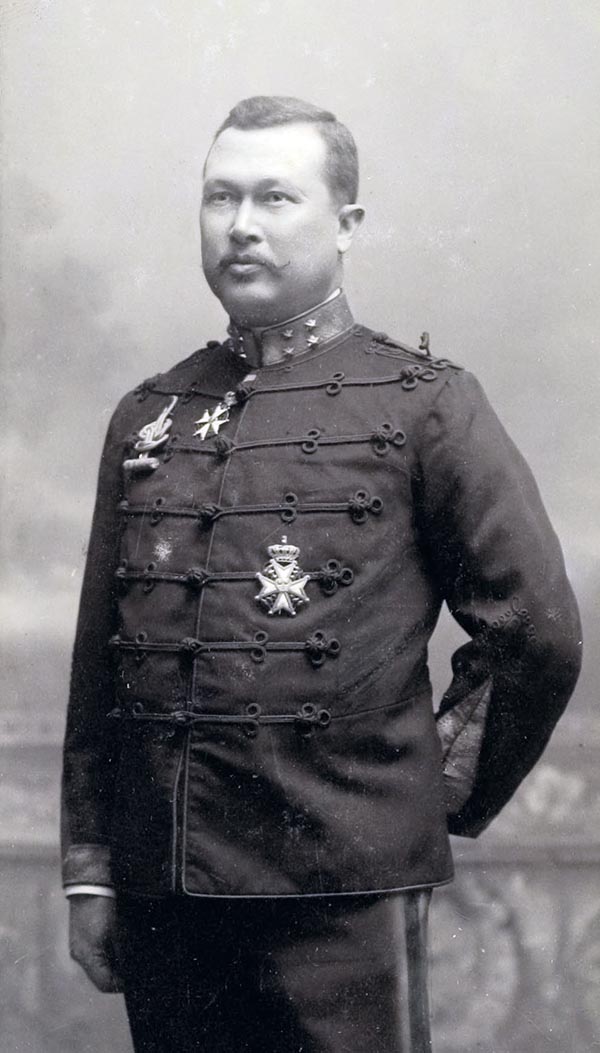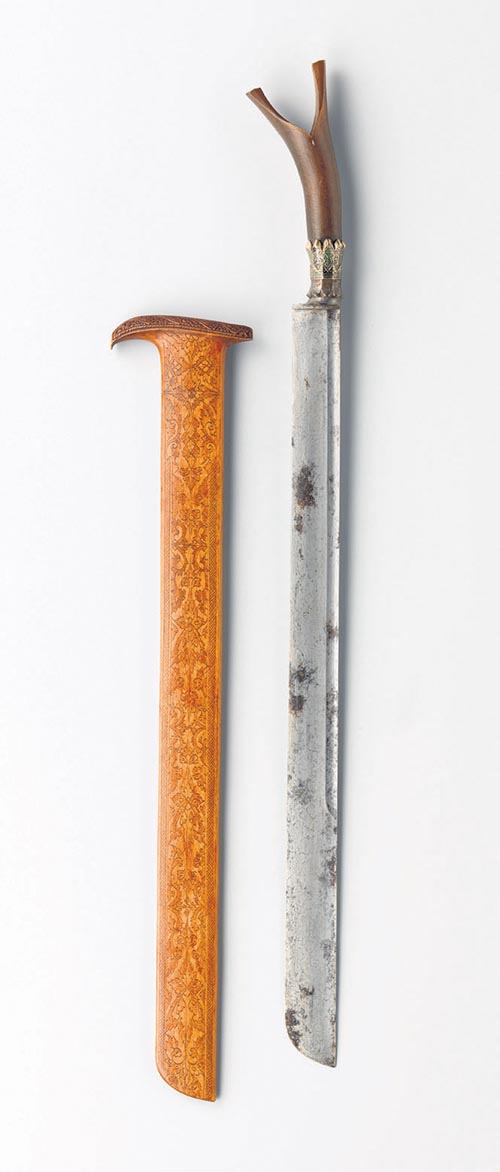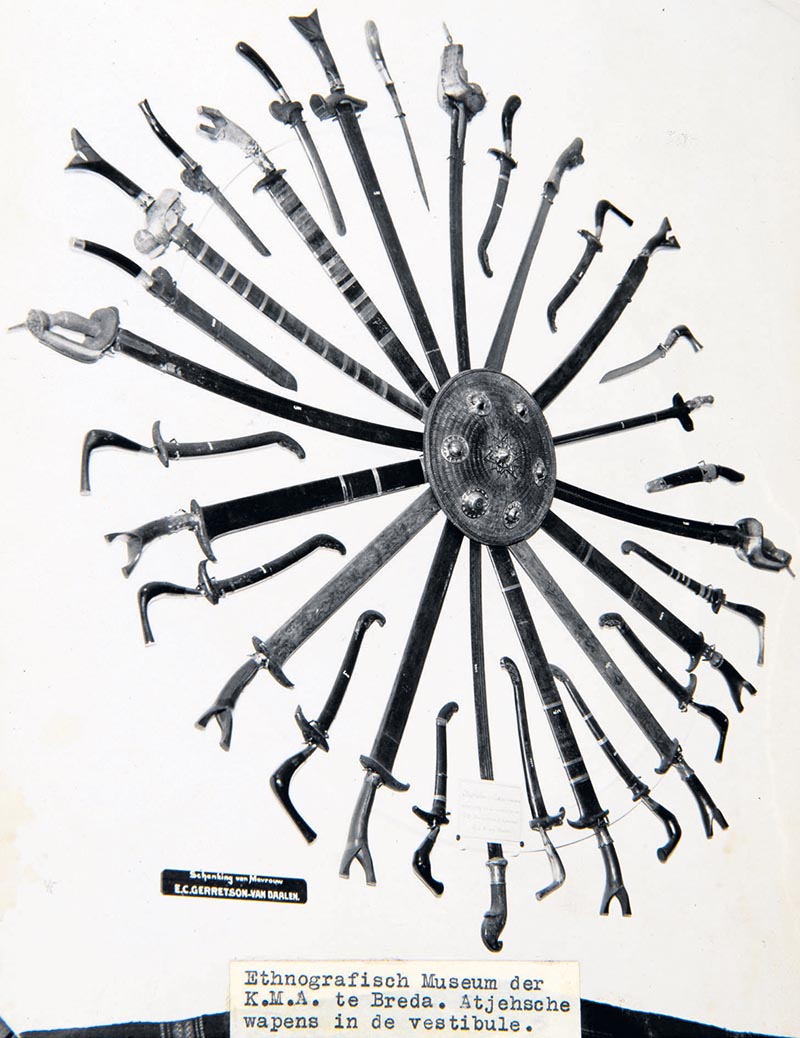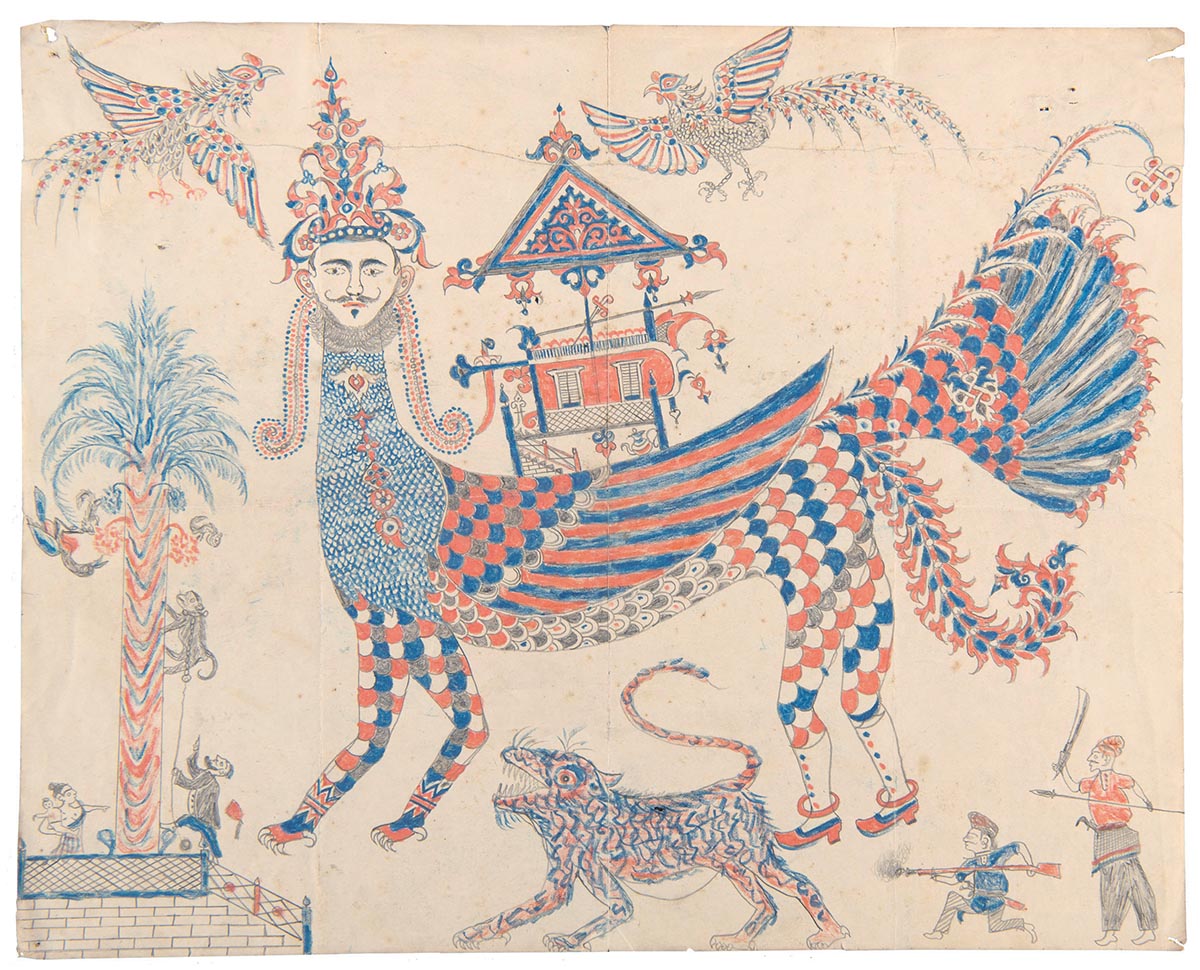By Force of Arms: Collecting During the Aceh War
The vast majority of objects from Aceh in Dutch museums came there through the hands of the military. This fact is related to the long period of the Aceh War (1874-1914) that was followed by continued popular resistance. The following is an analysis of the collecting practices of army officer G.C.E. van Daalen (1863-1930), which provides insight into how high-ranking officers acquired objects, against the backdrop of varying degrees of pressure and violence. An overarching question is what it means that almost all collecting was done by military staff and in the context of conflict and resistance to colonial rule.
Gotfried Coenraad Ernst van Daalen, also known as Frits van Daalen, was a high-ranking military officer of Indo-European descent in the Royal Dutch East Indies Army (Koninklijk Nederlands Indisch Leger or KNIL) [Fig. 1]. Already notorious during his lifetime, he owed his infamous reputation to the brutal campaigns he headed in Aceh during the first years of the 20th century. What is less known is that he was also an avid collector who assembled collections for a wide range of museums in both the Netherlands and the Dutch East Indies. Today, these objects are dispersed over more than a dozen museums, libraries, and archives in Jakarta, Amsterdam, Leiden, Rotterdam, Breda, and Cologne. 1 For the PPROCE project, the provenance of two objects was further investigated.

Fig. 1: Frits van Daalen, 1909. Photograph K. Karsen Jr. Collection Leiden University Library KITLV 7810.
One of the objects under investigation was an Acehnese sword, a sikin panjang, that is currently in the collection of the Rijksmuseum in Amsterdam [Fig. 2]. The sword has a decorated sheath, the blade is damascened (featuring pamor), and it has a decorative crown (glupa) of gold adorned with plant motifs filled in with blue and green enamel. In other words, this is a weapon of high aesthetic quality, which was probably made in the period before the Aceh War. The Rijksmuseum acquired it in 2004 from the bequest of Theodorus A.W. Ruys (1904-1989), a Rotterdam shipowner, and assumed that it might have belonged to Van Daalen. That assumption was easily confirmed. Among specialists, it is known that Van Daalen owned a private collection of weapons, which his heirs loaned to the Museum of the Royal Military Academy in Breda after his death, and which they subsequently sold to various parties. An investigation of the Breda museum’s archives indeed brought to light a list of Acehnese weapons from the Van Daalen collection, including one with the same inventory number that is still inscribed on the sword, and even a photograph of the sword on display at the museum’s premises [Fig. 3].

Fig. 2: Sikin panjang, 19th century. Collection Rijksmuseum NG-2004-47.

Fig. 3: Display of the Van Daalen collection in the Ethnographic Museum of the Royal Military Academy in Breda, c. 1938. The sikin panjang is in the bottom right-hand quadrant with number 4373. Collection Nationaal Museum van Wereldculturen RV-11996-1.
Equally relevant, however, was finding out how Van Daalen acquired the sikin panjang, especially since earlier research has shown that he obtained many objects directly “in the field” – in this case, the battle fields of Aceh. Two military campaigns in particular provided him with the opportunity to assemble systematic collections: the 1901 exploratory mission to the Gayo region and the extremely violent campaign to conquer the Gayo and Alas regions in 1904. The latter military expedition also had a scientific purpose, as the official report explains: “the goal is to get scientific results too, as far as the military aims and the difficult circumstances in which the column has to operate will allow […] finally a very complete and extensive report on the Alas people, who were entirely without description until now, will be brought out.” 2 To this end, a botanist of the ‘s Lands Plantentuin in Buitenzorg (the present-day Kebun Raya Bogor) came along to collect specimens of plants and insects; cartographic mappings of the terrain were carried out; and a mining engineer collected specimens of the ground. The specimens were sent to the Plantentuin as well as the Rijksherbarium in the Netherlands (these are currently held by Naturalis Biodiversity Center in Leiden). Van Daalen took it upon himself to collect ethnographic objects and manuscripts. The objects were distributed to museums in Batavia, Leiden, and Rotterdam, and the manuscripts were sent to Christiaan Snouck Hurgronje (1857-1936), the renowned scholar of Islam. Archival sources show that he started to collect in the early 1890s, shortly after his arrival in Aceh.
The outcome of the research carried out for PPROCE was that it cannot be determined how exactly the sword was acquired. This is because Van Daalen wrote only in general terms about the weapons he obtained, so only rare and unique items in his collection can be identified. The sikin panjang that is now in the collection of the Rijksmuseum, although of high quality, has no unique appearance nor striking features that testify to its individual history, which makes it more difficult to identify in written sources. However, a general picture of how Van Daalen acquired weapons can be sketched. The KNIL did not have official guidelines until 1928, but in practice looted weapons had to be handed over to the highest commander in the field, who would keep them at the disposition of the government. That Van Daalen did not always keep to this informal rule is clear from letters he wrote to his wife Betsy. For example, on 4 July 1896 he wrote about a battle in the village of Anagalung: “At around 4:30 am we drew up to the place, the first shot was fired at 4:45 followed by the assault and hand-to-hand combat in the benteng [fortress] and at 5 am it was all over. It was an interesting thing, that battle, all quite dark and no sound other than the cracking of gunfire and the yelling of the natives. Not surprising given that the Acehnese left in our hands 110 dead bodies and two little boys of five and six years old with minor injuries. Naturally several weapons were captured of which I have three fine specimens.” 3
According to fellow officer Harko Schmidt (1879-1953), Van Daalen habitually confiscated looted weapons to add to his collected items: “During a battle under his command, a lieutenant captured a golden shafted lance and asked Van Daalen if he could keep this weapon as a souvenir. Van Daalen took the weapon with an ice-cold stare, handed it over to an orderly standing behind him and said: ‘if anyone is entitled to this weapon, it is me’. And the lance went to the museum. With the troops, the ‘iron’ general therefore had the name that in his eyes everything was ‘gua punya’ [mine], but that was not known there – and Van Daalen thought it unnecessary that people knew – that all such loot was sent to the museums.” 4
The research disclosed that, in addition to spoils of war and other ‘finds’ during military operations, Van Daalen also acquired weapons by purchasing them from Acehnese contacts. In correspondence with Snouck Hurgronje, he writes about high-ranking members of the nobility selling precious weapons and manuscripts to him, making it clear that sometimes pressure was necessary to get things “out of their hands.” 5 Occasionally, he commissioned blacksmiths to make a new weapon, if it was a rare type that was not otherwise available. It is clear, however, that the objects that Van Daalen obtained through purchase tended to be unusual and unique pieces. It is therefore more likely that the sikin panjang in the Rijksmuseum collection was obtained as a spoil of war rather than through purchase or other means.
The second case of research into Van Daalen’s acquisition practices concerned two pencil drawings. In the repository of the National Museum of World Cultures (Museum Volkenkunde collection), there are 15 drawings, all with imaginative depictions of various scenes. They were made by Teuku Teungoh, ulèëbalang (aristocratic leader) of the village of Pate on the west coast of Aceh. The drawings are exceptional because little figurative drawing is known from Aceh. Prior to the provenance research, little was known about Teuku Teungoh as a person, and the museum mistakenly named him Teungku Teungoh. Two of the drawings, both donated by Frits van Daalen, turned out to have crucial information on the reverse, which was previously overlooked by the museum. On the drawings, the artist had written a plea in Malay, addressed to the civiel gezaghebber (civil commander), the Dutch military authority in Pulo Raya. The text shows that Teuku Teungoh was in prison.
The first of these drawings depicts Buraq, the creature that accompanied the Prophet Muhammad on his night journey and his ascension to Heaven (al-’isra’ wal-miʿraj) [Fig. 4]. The legendary creature is often portrayed in Islamic iconography as a fabulous animal with the head of a woman, the body of a horse, and wings. In this drawing, however, Buraq has the head of a man and the body of a horse (but with clawed feet or wearing shoes) besides the more common wings and peacock tail. The other drawing shows Buraq as a bird, which is not unusual in Indonesian images, surrounded by parrots, butterflies, and two trees (one with a serpent in it). 6 There are four men depicted: one wearing a fez and a large sword, throwing a spear; another with a load on his head, carrying a basket; and a third one, also wearing a fez, punishing the fourth man.

Fig. 4: Teuku Teungoh, drawing of Buraq, pencil on paper, 1903-1904. Collection Nationaal Museum van Wereldculturen RV-1429-134.
Both drawings contain on the reverse pencil inscriptions in Malay in Jawi script, written by Teuku Teungoh, addressed to the civil commander [Fig.5]. 7 On one of them there is also a note in Dutch, written by Frits van Daalen, stating that the Teuku is writing from prison in Pulo Raya, and that he is requesting: (1) grace, (2) a small knife, and (3) permission to take a walk. However, according to Dr. Annabel Gallop, Lead Curator of the British Library’s Southeast Asia collections, Van Daalen made a mistake in interpretation. The first line in Malay is not a specific request for grace or a pardon, but just the conventional preamble appropriate for a humble request made to an overlord.

Fig. 5: Reverse of the drawing, on which the imprisoned Teuku wrote a plea for help directed to the civil commander. Collection Nationaal Museum van Wereldculturen RV-1429-134.
The request reveals that the Teuku tried to use the presentation of the drawings to the civil commander to send out a cry for help. During the research it was discovered that the civil commander in question was most likely Theo Veltman (1868-1943), who held the office between October 1903 and March 1905; alternatively, it might possibly have been Henri Swart (1863-1946), who was appointed as the first civiel gezaghebber of Pulo Raya in July 1902. Both officers were avid collectors (although Swart focused more on weapons), and Teuku Teungoh is strengthening his plea by referring to an object, possibly a receptacle, which the civil commander apparently had requested him to make: “Many greetings, I proffer my pardons to beneath the shoes of Sir, hoping for help for my affairs, because I am but a poor man, hoping for forgiveness for any wrongdoings. This is what I am hoping for: unless Sir gives me a small knife, it will no longer be possible for me to make it, Sir, because I will not be able to make the receptacle [?].” 8
The inscription on the second drawing commences with a similar expression of humility and is, again, followed by a rather desperate plea for help: “Many greetings, to beneath the shoes of Sir, with my hopes for permission from Sir, that Sir should give the order for me to be taken for a walk each day, because for so long now I have been kept in, unable to see anything, and I have frequently fallen ill; this is my never-ending hope entrusted to Sir.”
Thus, while in prison, Teuku Teungoh asked the governor to lighten his regime, requesting time out of his cell to see the daylight and to go for a walk. The investigation did not make clear why he was imprisoned, nor whether he was punished for political or criminal activities. However, in the years directly after the death of famed resistance leader Teuku Umar (1899), there were pockets of resistance active on the west coast, including Pulo Raya district. In those years ulèëbalang were sometimes imprisoned for lack of cooperation with the Dutch authorities. The Koloniaal Verslag (Colonial Report) on 1902 reports that the prison of Pulo Raya held 55 prisoners, half of whom were reported ill during the year, and 10% of whom died. These numbers tell us something about the conditions in the prison, and Teuku Teungoh also mentions that he had frequently fallen ill. Via the civil commander, two of the 15 drawings came into the possession of Frits van Daalen, who donated them to Museum Volkenkunde in 1904. The other 13 drawings were sold to the museum in 1907 by Theo Veltman, probably the civil commander in question.
Today, various objects that were owned by Van Daalen and his fellow officers are on display in museums in the Netherlands. What is the impact of these collections on the public imagination? Several scholars have argued that the Aceh War shaped official historiography and popular conception to such an extent that today Aceh is rarely shown in dimensions other than war and religious fervour. This image is confirmed by the museum collections in the Netherlands. In 1942, when the Dutch left Aceh, collecting stopped completely, and, apart from a handful of objects, therefore, everything in the museums was taken out of Aceh during the period of colonial rule. Around 20% of the total collection of Acehnese objects in the National Museum of World Cultures are weapons, reflecting the fact that most collecting was done by the army. In contrast to other parts of Sumatra and Java, where curators undertook collecting trips from the 1970s onwards so that museums could represent contemporary Indonesia, the Dutch museums contain virtually no Acehnese objects from the post-independence period. This effectively freezes Aceh in its image as a setting of colonial conflict.
Mirjam Shatanawi is lecturer at the Reinwardt Academy (Amsterdam University of the Arts) and was one of the researchers affiliated with PPROCE. Her work focuses on representations of Islam in museums, including the collecting and display of colonial-period collections from Indonesia. Email: mirjam.shatanawi@wereldculturen.nl